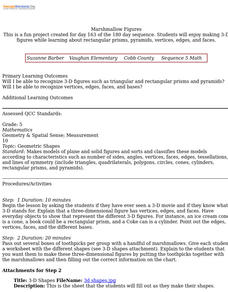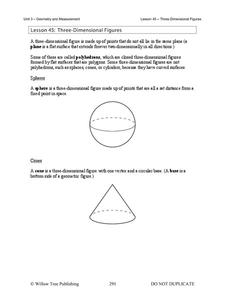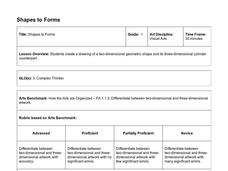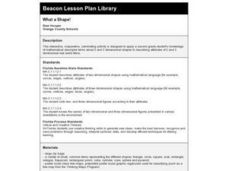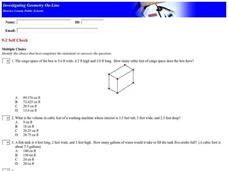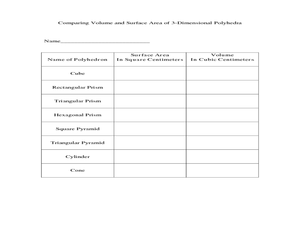Cord Online
Pyramids and Cones
Young mathematicians find the surface area and volume of a square pyramid and a cone. In what looks like a typical activity out of a textbook, you'll find an activity where learners find an unknown measurement of a pyramid or...
101 Questions
Pyramid of Pennies
Go big or go home! Learners watch a video rendition of the creation of a penny pyramid. Their task is to determine the number of pennies in the pyramid. The lesson encourages multiple methods, including function building or volume formulas.
EngageNY
The Volume Formula of a Pyramid and Cone
Our teacher told us the formula had one-third, but why? Using manipulatives, classmates try to explain the volume formula for a pyramid. After constructing a cube with six congruent pyramids, pupils use scaling principles from...
Curated OER
Marshmallow Figures
Students enjoy making 3-D figures while learning about rectangular prisms, pyramids, vertices, edges, and faces. After a lecture/demo, students use marshmallows, toothpicks and a worksheet imbedded in this lesson to create 3 dimensional...
Curated OER
Living in a Geometrical World
Students participate in a series of hand-on, online, and multimedia activities to examine 2 dimensional and 3 dimensional shapes. They describe common geometric solids. They construct rectangular prisms using straws and ribbon.
Curated OER
Volume of Solids: Algebra/Geometry Institute
Use this volume of solids lesson to have learners find the surface area and volume of cylinders, pyramids, and prisms. They place cubes inside three-dimensional figures to determine the volume. Worksheets and answers are provided.
Curated OER
Problem Solving - Use a Formula 21.7
In this formula worksheet, students complete a graphic organizer, answering the questions relating to: understand, plan, solve, look back. Students solve 2 problems. Houghton Mifflin test is referenced.
Curated OER
Which container holds a larger amount of popcorn?
What does popcorn have to do with math? Seventh grade mathematicians are provided an opportunity to develop a conceptual understanding of the formula for volume and to use it as a tool to solve problems. The lesson begins with a...
Los Angeles County Office of Education
Assessment For The California Mathematics Standards Grade 6
Test your scholars' knowledge of a multitude of concepts with an assessment aligned to the California math standards. Using the exam, class members show what they know about the four operations, positive and negative numbers, statistics...
Curated OER
Volume and Surface Area of Right Rectangular Prisms
Students identify the formulas for three-dimensional figures. They use manipulatives to model problems. Students create foldables and explain volume and surface area. Students complete worksheets and classify solids. Students sing a...
Curated OER
Solving Multistep Linear Equations
For this multistep linear equations worksheet, 10th graders solve and complete 21 different multiple choice problems. First, they determine the value of a given variable by using multisteps. Then, students determine the equation that...
Curated OER
Finding Patterns in Pyramids and Prisms
In this finding patterns in pyramids and prisms worksheet, 4th graders use two tables showing faces, edges and vertices for pyramids and prisms to answer six questions about the patterns.
Houghton Mifflin Harcourt
Unit 3 Math Vocabulary Cards (Grade 1)
Reinforce math vocabulary with a set of flashcards. Each card showcases a boldly typed word or a picture representation with labels. The topics are geometry related and include terms such as cones, faces, pyramids, sides, and...
Curated OER
3-D Attributes
Students explore geometric solids. For this geometry lesson, students listen to the book The Greedy Triangle by Marilyn Burns, then work in groups to sort geometric solids into various categories. Students define geometric solids...
Willow Tree
Three-Dimensional Figures
Time to move into the third dimension! Learn the names of the geometric solids and count faces, edges, and vertices. Then learn to recognize nets that create a given solid.
Curated OER
Shapes to Forms
Here is a math lesson that is really a visual arts lesson in disguise! In it, pupils utilize their knowledge of geometric shapes and forms to create a detailed version of a cylinder. The instructions on how to go about the task are very...
Curated OER
Pacing a Gunther Chain
Students pace a Gunther Chain, a measurement used by foresters to determine distance and area. They discuss that pacing is individualized depending on age, gender, etc. They practice to find an average pace. Teams estimate, pace and...
Youth Education Services
Relating Volume in 3D Objects with Ten Problems
A fabulous four-page assignment explores volume formulae for rectangular prisms, cylinders, cones, and pyramids. Pupils apply the formulas to solve problems, match diagrams to values, and address real-world scenarios. A detailed answer...
Curated OER
What a Shape!
Second graders culminate their study of shapes by describing the shapes using the proper mathematical descriptors.
Curated OER
Geometric Patterns and Relationships
Fifth graders explore three-dimensional figures. As a class, they discuss the characteristics of various three-dimensional figures. In groups, 5th graders write riddles describing the geometric shape. Partners read each other's...
Curated OER
Volume
In this geometry worksheet, 10th graders solve problems that involve area of a rectangular prism and lateral area of a pyramid. The one page interactive worksheet contains five problems. Answers are not provided.
Curated OER
Identify Faces of Solid Figures
In this identifying faces of solid figures activity, students solve each of the 6 problems that require them to identify the faces of a cylinder, box, cone, and pyramid.
Curated OER
The Value of Volume
Students measure the perimeter and area of their polygons. In this geometry lesson plan, students calculate the volume and area using the correct tools. They calculate the time and temperature and the perimeter and side lengths of...
Curated OER
Solid Shapes
In this solid shapes instructional activity, students read descriptions of solid shapes, then label a set of pictures with either box, cylinder, pyramid or cone.



